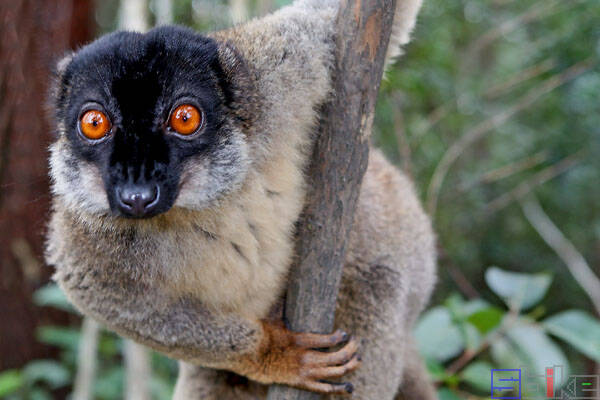Eulemur albocollaris
IUCN
LCBasic Information
Scientific classification
- name:Eulemur albocollaris
- Scientific Name:Eulemur albocollaris,White-collared Lemur
- Outline:Primates
- Family:Lemuridae Lemuridae
Vital signs
- length:43-50cm
- Weight:2-3kg
- lifetime:20-25years
Feature
The face is slightly dark, with white hairs around the face
Distribution and Habitat
The white-collared lemur is found in Madagascar: restricted to the forests between the Manampatrana and Mananara rivers. It is found in tropical rainforests, in moist montane forests and in dry deciduous forests. The lemur is arboreal, spending most of its time in the upper levels of the tree canopy.
Appearance
The white-collared lemur is a medium-sized lemur. The head and body are 43-50 cm long, the tail is 41.5-51 cm long, and the weight is 2-3 kg. The color of the upper body ranges from brown to yellow or black, the fur on the back is brown-gray, and the lower body is slightly grayish white. The ventral side is grayish white, the tail is darker, the face is slightly black, the mouth and crown are usually dark, from dark gray to black, there are light spots above the eyes, and there are white whiskers around the face. There is pale gray-brown fur around the ears, cheeks and under the chin. The tail is densely furred and the back is arched when moving on the ground or branches. The eyes are a rich orange-red.
Details
White-collared Lemur (scientific name: Eulemur albocollaris) is also known as White-collared Lemur. It was once a subspecies of brown lemur and was confirmed as an independent species in 2008.

White-collared Lemur is active at different times throughout the day and night. It is gregarious, but the group is not fixed. Usually the group is 3 to 12 individuals, sometimes 9-12 together. Each individual smears urine on the body as a scent identification. There is overlap in territory, but neighboring groups generally avoid contact. They are highly adaptable to the forest.
The white-collared lemur forages in trees or on the ground. They are omnivorous, and their main food is fruits, plants and gums. They also eat bread, biscuits, monkey food, bananas, apples, guavas, tomatoes, monkey rice cakes, papayas, cucumbers, carrots, etc. In some areas, they also eat insects, centipedes, millipedes, etc.
The reproduction of white-collared lemurs is seasonal, and mating usually occurs in May and June. The gestation period is about 120 days, and the cubs are born before the rainy season in September and October. Generally, only one offspring is born per litter, and twins have also been reported. They reach sexual maturity in 1-3 years, and their lifespan in the wild is 20 to 25 years.
The white-collared lemur has a limited range and is considered to be in a very low population. The species is suspected to have a population decline of ≥80% over a three-generation period (24 years, 8 years per generation). This time period includes both the past and the future. The reason for the lack of cessation is due to habitat degradation and loss, including hunting. In 1997, a strong typhoon reduced the number of white-collared lemurs along the coast by about 50%. In addition, the species has experienced significant hybridization with gray-headed lemurs and red-collared lemurs in the northern range (about half of the total), and the coastal populations have both experienced significant genetic bottlenecks. Based on these premises, the species is listed as critically endangered.
Listed in the 2013 Red List of Endangered Species of the World Conservation Union (IUCN) ver 3.1 - Critically Endangered (CR).
Listed in the CITES Appendix I of the Washington Convention as a protected animal.
Protect wild animals and eliminate game.
Maintaining ecological balance is everyone's responsibility!








